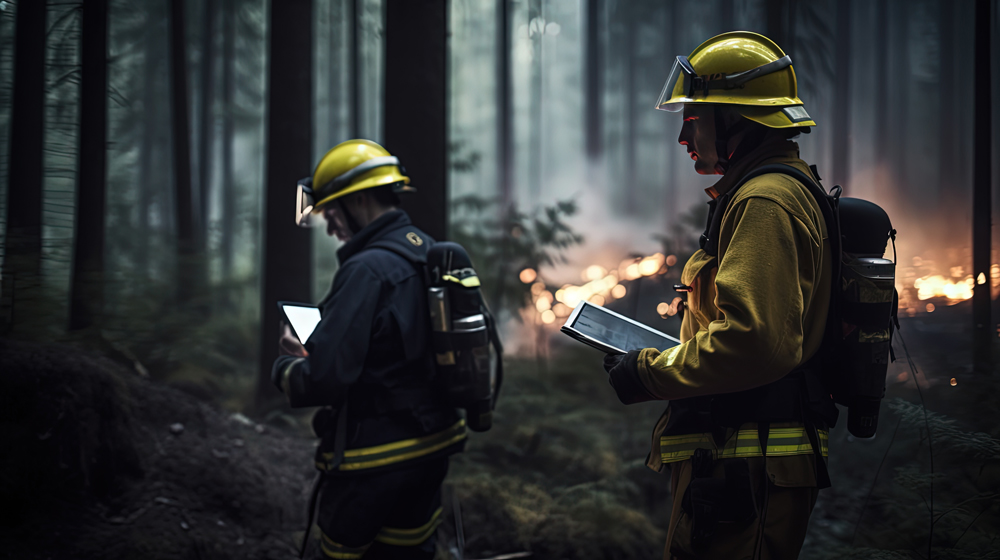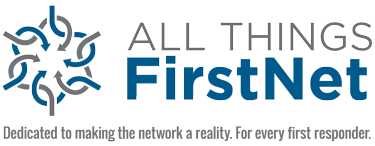
Firefighting during natural disasters is one of the most dangerous jobs that a first responder can do. This is why effective, reliable fire communication is an absolute must for fire department officers, their commanders, and the police and EMS agencies that they work with on scene.
Of course, the best firefighter communication systems are those that can work seamlessly among all U.S. first responders, without the incompatibility issues that afflict proprietary land mobile radio (LMR) systems. The best systems also cover as much of the continental United States as possible, carry data and video as well as voice traffic, and provide priority/preemption service to first responders over all other users.
In the U.S. — and indeed the world — there is only one public safety wireless broadband network that satisfies all of these conditions: FirstNet. Managed by the FirstNet Authority, which was established by Congress under the Middle Class Tax Relief and Job Creation Act in 2012, FirstNet has been purpose-built to serve fire, EMS, police, and other first responder agencies first using smartphones and tablets. It was born out of the tragic lessons learned during 9/11, where incompatible and inadequate LMR service resulted in the needless deaths of first responders and some members of the public.
“Having effective communications during emergency situations is imperative for everyone in public safety,” said Chief Kim Zagaris, Senior Operations Advisor/Wildfire Policy and Technology at the Western Fire Chiefs Association. (‘Chief Z’, as he is called, spent 18 years as State Fire and Rescue Chief for the State of California, Governor’s Office of Emergency Services, of his 48 years in the fire service until he retired.) “This is why FirstNet was created in response to 9/11, and why FirstNet is so vital during natural disasters when the commercial cellular networks are overloaded and prone to service failures.”
Why Effective Communication is Critical for Firefighters During Emergency Situations
There are so many reasons why effective communications are vital for firefighters, which we have touched upon in brief. Here are some of those reasons in detail.
Keeping Everyone Connected
Disaster scenes are dangerous places, with lots of hazardous conditions where firefighters can be lost, injuredinjured, or killed. The reliable service provided by FirstNet (with support from AT&T) means that fire commanders can stay in touch with personnel and track their locations in real-time. This kind of monitoring makes it straightforward and simple to alert firefighters to hazards on the scene and identify and assist any personnel who have found themselves in trouble.
Fast, Reliable Information Transmission
Accurate, up-to-date information is key to keeping firefighters safe, informed, and responsive to the latest threats. The FirstNet network’s 4G/LTE signal carriage — and 5G is coming! — means that voice, video, and data are moved from one user to another quickly and reliably. .
Connections with Other Agencies
When an emergency occurs, the public safety response isn’t confined to one type of first responder agency. Fire, EMS, police, utilities, and anyone else who might be able to help is called to the scene to assist. This is where FirstNet excels, because there are over 7 million FirstNet users connected to the network today nationwide from departments large and small. This massive user base makes it far easier for public safety agencies to connect with each other — especially during multi-agency responses to natural disasters when teamwork counts
What FirstNet Offers Fire Departments That Commercial Networks Don’t
There are many facts that back up FirstNet’s status as the only true public safety wireless network in the United States.
Dedicated Band 14 Spectrum with Priority & Preemption
First, there’s Band 14. It is a slice of the U.S. wireless spectrum that Congress set aside for the sole use of first responders, and FirstNet has it.
Second, there’s Priority & Preemption. Besides operating Band 14 on FirstNet’s behalf, AT&T (the wireless carrier that won the FirstNet carriage contract through a competitive bidding process) provides all FirstNet users with Priority & Preemption service on their entire commercial cellular network, anywhere in the USA. “This ensures that FirstNet users always have priority above everybody else,” Chief Zagaris said. “If necessary, the preemption will kick other people off and prioritize who needs to be on there for us.”
Nationwide, Interoperable Coverage — Even in Rural and Remote Areas
FirstNet’s coverage of the continental U.S. is unmatched by any other cellular carrier. While coverage is good FirstNet is committed to working with first responder to make it even better, including the remotest and most rural areas of the country.
“Currently FirstNet covers 2.99 million square miles,” said Chief Zagaris. “That’s pretty good, but we’re going to do even better through investments in additional coverage. I like to say that ‘coverage is king’, which is why part of the money that comes from FirstNet’s monthly user fees goes into an account to expand coverage and add 5G service to our network.”
FirstNet Deployables – Rapid Connectivity When Infrastructure Fails
When natural disasters strike, cellphone transmitters and towers can fail. Fortunately, FirstNet’s
Response Operations Group (ROG) is here to help. ROG is made up of former first responders who have access to more than 180 dedicated deployable network assets, including Satellite Cells on Light Trucks (SatCOLTs) and Cells on Wheels (COWs). Essentially mobile cell sites that link to FirstNet via satellite, these rapidly deployable assets (with their own generators) can be booked by FirstNet members for delivery to disaster sites in 14 hours or less. Once on site, the ROG assets can restore cellular service to first responders and other authorized users extremely quickly.
FirstNet in Action During the LA Wildfires
The January 2025 Palisades and Eaton wildfires in Los Angeles were some of the most destructive fires in California’s history. When they started to knock out cellular service in the areas, FirstNet’s ROG sent numerous resources to restore service. This is just what FirstNet does during such wildfire emergencies.
“FirstNet sent six of their largest deployables to help fight the Los Angeles wildfires, such as their COWs,” Chief Zagaris said. CalFire deployed their own FirstNet Compact Rapid Deployables (CRDs) in the wildfire zone to provide added coverage in the affected area as well. (The CRD is so small and compact that it can be set up by a single person in minutes.). As technology has continued to evolve the innovation of the FirstNet CRDs and the Mini CRDs it has allowed agenciesy custom to purchase approximately 600 additional units for there local use or use within the FirstNet System
As well, ROG sent FirstNet Emergency Response Kits to the LA wildfires. Each kit comes with 20+ FirstNet Ready smartphones in a protective case for simultaneous recharging and distribution. FirstNet traffic in the fire zone was supported on 5G as well as 4G/LTE, for maximum data throughput and performance.
Features That Improve Fire Communication with FirstNet
Beyond the many features outlined above, FirstNet improves fire communication through FirstNet Push-to-Talk (PTT) and Live Data Sharing
FirstNet PTT
FirstNet Push-to-Talk (PTT) brings the one-button PTT features found in legacy handheld radios to modern smartphones. Using FirstNet PTT, firefighters can hit one button on their smartphones to connect to other team members, get access to prearranged talkgroups, and speak directly with handheld radio users.
Live Data Sharing
Need to share live data from the fire scene? Be it video, voice, maps, or other information, FirstNet can do it. “A good example are wildfires,” said Chief Zagaris. “We set up wireless cameras in hotspot areas and use FirstNet to send their live views directly to us.”
How Fire Departments Can Get Started with FirstNet
Clearly, the facts above illustrate how useful FirstNet can be for fire departments during natural disasters, and indeed all emergency situations.
So how can your agency sign on to FirstNet? “It’s as simple as just Googling FirstNet, but what I tell people to do is to ask an AT&T rep to come to your department and talk to you about it,” Chief Zagaris said. “Or you can connect to them directly, by just clicking here.”




Be the first to comment on "How FirstNet Improves Firefighter Communication During Natural Disasters"